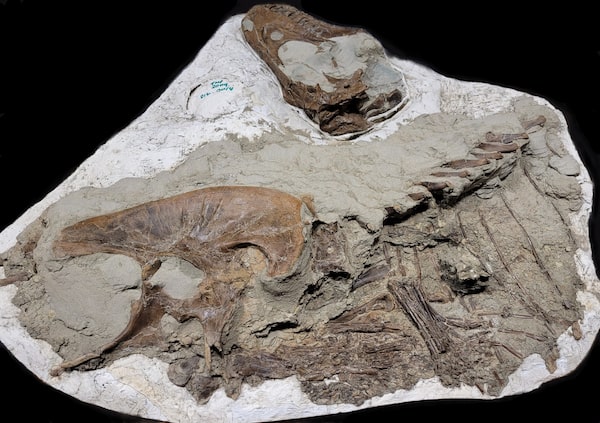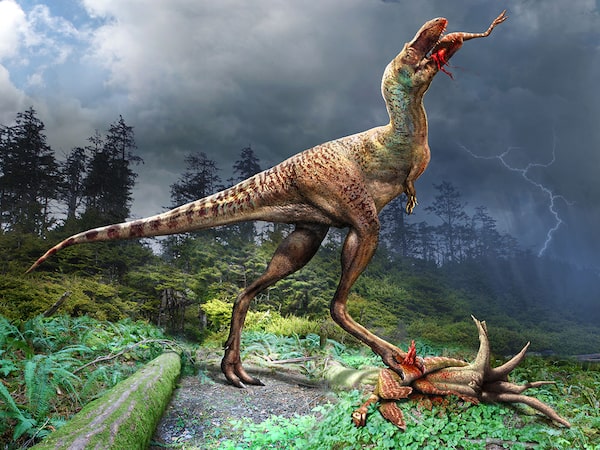
An artistic rendition of a young Gorgosaurus feasting on its prey, a smaller bird-like dinosaur called Citipes.Illustrations by Julius Csotonyi/Supplied
For any fossil hunter, unearthing the well-preserved skeleton of a young tyrannosaur – one of the top predators of the dinosaur world – could be the find of a lifetime.
But when the staff of Alberta’s Royal Tyrrell Museum of Paleontology began working on one such specimen, a cousin to T. Rex called Gorgosaurus libratus, they discovered it came with an additional prize.
Emerging from the tyrannosaur’s stomach was an extra set of toe bones.
“Those bones were way too small to belong to the tyrannosaur,” said François Therrien, the museum’s curator of dinosaur paleoecology, “And they were coming out of its rib cage.”
As rock was carefully removed, what emerged was the detached hind leg of a small, bird-like dinosaur. Then three more. Apparently the tyrannosaur had a taste for drumsticks.
The discovery, which marks the first time a tyrannosaur of any age or species has been found with fossilized stomach contents, sheds new light on the behaviour of a young predator that could have reached nine metres in length and three tonnes in weight had it lived to maturity.

The right side of a Gorgosaurus juvenile found with bones of prey items in its stomach (bottom centre).Darla Zelenitsky/Supplied
“This is a tyrannosaur’s last meal, preserved in stone. How amazing is that?” said Steve Brusatte, a specialist in dinosaur biology at the University of Edinburgh who was not involved in the discovery.
Until now, fossilized feces and teeth marks on the bones of large herbivores offered the only evidence of what adult tyrannosaurs ate when they were the world’s top predators millions of years ago.
The specimen uncovered by the museum had only one-tenth the body mass of an adult. Based on their lighter builds, researchers have long suspected the feeding habits of juvenile tyrannosaurs were different from that of their giant-sized parents.
“They would have been agile in life, fleet-footed compared to the adults,” said Darla Zelenitsky, a paleontologist and associate professor at the University of Calgary who co-led a study of the fossil, published Friday in the journal Science Advances. “What we see from this specimen is that while the adults were off hunting very large dinosaurs, the juveniles were after smaller prey.”
The research helps solve a long-standing riddle from the late Cretaceous, the geologic period in which the young Gorgosaurus lived some 75 million years ago.
According to the fossil record, meat-eating species of dinosaurs mainly came in two sizes at that time: small and extra-large. Carnivores of intermediate size seem to be absent from the picture. The new specimen suggests it was juvenile tyrannosaurs who filled that role.
“They were the coyotes of this ecosystem,” Dr. Zelenitsky said.
The idea that young tyrannosaurs feasted on smaller and different prey was predicted, notably in a 2021 article by University of Maryland paleontologist Thomas Holtz Jr.
Dr. Brusatte said researchers also had to consider the alternative possibility that young tyrannosaurs tagged along with their mature relatives and partook of their massive kills.
“But that doesn’t seem to be the case here – the little tyrannosaurs ate little prey, so they probably actively hunted their own food and changed the prey they targeted as they got bigger,” Dr. Brusatte said. “They had to grow into their bone-crushing personas.”
He added that the interpretation was likely to be “broadly applicable” to other tyrannosaur species, including T. Rex.
Dr. Zelenitsky said the fact that the young tyrannosaur’s stomach contained two pairs of hind legs, with one set more digested than the other, reinforces the idea that its meal choice was not a fluke.

According to Darla Zelenitsky, a paleontologist and associate professor at the University of Calgary, the fact that the young tyrannosaur’s stomach contained two pairs of hind legs, with one set more digested than the other, reinforces the idea that its meal choice was not a fluke.Illustrations by Julius Csotonyi/Supplied
The legs belonged to Citipes elegans, a type of small feathered dinosaur thought to have been plentiful during its breeding season, based on evidence that females laid 30 or more eggs to a clutch.
Researchers found the prey were less than a year old, while the Gorgosaurus was between five and seven.
The specimen offers no evidence of how the Gorgosaurus died. But its intact body made it an ideal time capsule for the dietary evidence found inside.
The specimen was first spotted in 2009 by Darren Tanke, a fossil preparation technician at the museum, during a field expedition in Alberta’s Dinosaur Provincial Park.
But it was not until the following year, after the fossil had been transported to the museum, that Mr. Tanke exposed the small foot bones that were inside.
The museum’s team then stopped to consider their options and decided to turn the embedded fossil over to the side that offered better access to the dinosaur’s stomach contents. The delicate manoeuvre was executed in 2011 and the team continued to work at exposing the fossil and its stomach contents, which they identified through comparison with other museum specimens.
A number of experts, including Canadian paleontologist Phil Currie, participated in the analysis of the specimen. The fossil is now available for other experts to study, though Dr. Therrien said it will be another year at least before it is ready for display at the museum.
In the meantime, he said, more specimens continue to emerge from Alberta’s badlands with each field season offering a chance at fresh insights.
“Even if we don’t find a new species, there’s always going to be a specimen that tells you something new about these animals,” he said.